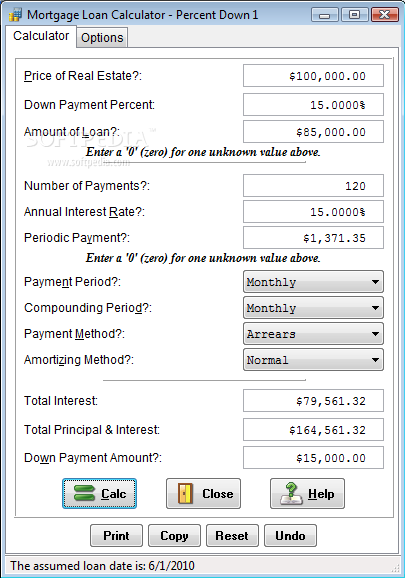
My guess is you set the calculation up to have an irregular length first period, and that’s why there is a difference in the payment calculation. (This calculator is not just for mortgages.)Īs to the payment calculation, are the loan closing date and the first payment date exactly one payment frequency apart? If not, how are you setting either the long or short initial period interest calculations options under "settings"? Those settings can impact the payment calculation. If you want no compounding, set the payment frequency and compounding frequency to the same value. I, therefore, can’t advise, but I can give you some pointers. All details are important (for example, what’s the loan amount? 🙂 ). This option is to accommodate businesses with fiscal year ends that do not coincide with the calendar year-end. Year-End Month - this setting establishes after what month the calculator shows year-end and running totals.Points, Charges, & APR Options - see loan schedules with points, fees, and APR support.A footnote on the payment schedule informs you of the rounding amount. Last Period Rounding Options - due to payment and interest rounding each pay period (for example, payment or interest might calculate to 345.0457, but a schedule will round the value to 345.05), almost all loan schedules need a final rounding adjustment to bring the balance to "0".Long/Short Period Options - settings for how interest is shown on the schedule when the initial payment period (the time between the loan date and first payment date) is longer or shorter than the selected payment frequency.The 366 days in year option applies to leap years, otherwise the interest calculation uses 365 days. This setting impacts interest calculations when you set compounding frequency to a day based frequency (daily, exact/simple or continuous) or when there are odd days caused by an initial irregular length period. These options are available by clicking on "Settings." Related: Three Easy Ways to Save on Your Next Loan For a complete explanation of these options, see Nine Loan Amortization Methods. Amortization Method - leave this setting set to "normal" unless you have a specific reason for setting it otherwise.More about loan schedules with points, fees, and APR support. Points - one point is one percent of the loan amount.Setting this option to "Exact/Simple" results in simple, exact day interest. Doing so results in simple, periodic interest. Compounding Period or Frequency - usually, the compounding frequency should be set to the same setting as the payment frequency.The schedule calculates the payment dates from the first payment due date (not the loan date). Payment Period or Frequency - how often do you want to schedule payments? The calculator supports 11 options, including biweekly, monthly, and semiannual (useful for bond coupon interest schedules).Four loan options you most likely don't need to touch. More details about the settings available for odd day and irregular period interest.
Pine grove financial calculators full#
However, if you want to match other calculators, then set the "Loan Date" and "First Payment Due" so that the time between them equals one full period as set by "Payment Frequency."Įxample: If April 10th is the "Loan Date" and the "Payment Frequency" is "Monthly," then set the "First Payment Due" to May 10th, that is if you want an estimated interest calculation. Important - Selecting dates will result in interest charges as well as payment calculations that do not match other calculators.



 0 kommentar(er)
0 kommentar(er)
